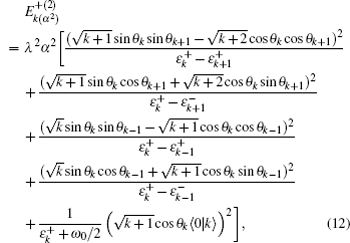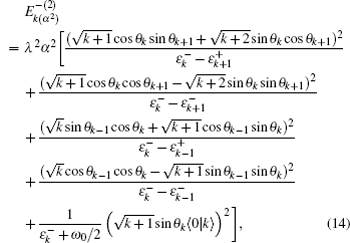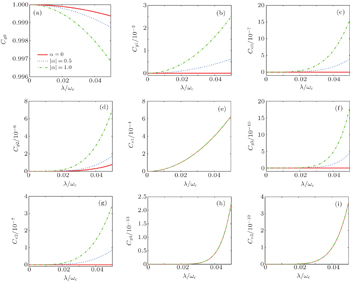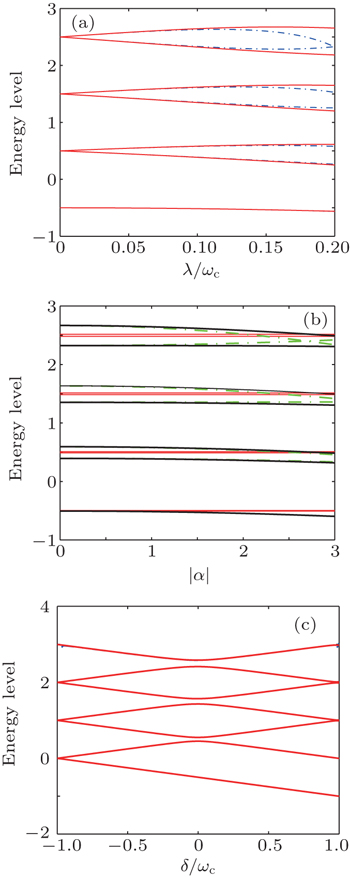† Corresponding author. E-mail:
‡ Corresponding author. E-mail:
A dressed-state perturbation theory beyond the rotating wave approximation (RWA) is presented to investigate the interaction between a two-level electronic transition of polar molecules and a quantized cavity field. Analytical expressions can be explicitly derived for both the ground- and excited-state-energy spectrums and wave functions of the system, where the contribution of permanent dipole moments (PDM) and the counter-rotating wave term (CRT) can be shown separately. The validity of these explicit results is discussed by comparison with the direct numerical simulation. Compared to the CRT coupling, PDM results in the coupling of more dressed states and the energy shift is proportional to the square of the normalized permanent dipole difference, and a greater Bloch–Siegert shift can be produced in the giant dipole molecule cavity QED. In addition, our method can also be extended to the solution of the two-level atom Rabi model Hamiltonian beyond the RWA.
Polar molecules bearing a permanent electric dipole moment (PDM) can provide strong, long-range, tunable, spatially anisotropic dipole–dipole interactions.[1] They have potential applications from high precision metrology[2] to chemical dynamics,[3] quantum information processing,[4] and the simulation of quantum many-body systems[5] etc. The PDM reflects direct information about the electronic charge–density distribution of polar molecules, and could be quite different between various electronic states. The difference of PDM arises from the change of molecular orbital.[6–9] For instance, in the alkaline earth-monohalides and -monohydrides, the decrease of PDM from the X2Σ state to the A2Π state is the result of the promotion of the sole unpaired valence electron from an s–p hybrid orbital to a more highly polarizable p–d hybrid orbital,[6–8] while in the alkaline monohydrides LiH, it is the result of the promotion from an s orbital to an s–p hybrid orbital.[9] Another type of giant dipole molecules are organic molecules with the delocalized conjugated π electrons. Such molecules often have excited electronic states of a charge transfer character, so there can be large differences of PDM between the electronic ground and excited states.[10] The interaction of a two-level polar molecule with a classical optical field has been studied by many researchers.[11–14] It is shown that the nonzero difference of PDM between the electronic ground and excited states can significantly affect the coupling between the polar molecule and the optical field, and is responsible for some new optical properties which are quite different from a regular atomic system, for instance, multi-photon transition,[15] nonlinear optical properties,[16] high harmonic generation,[17] etc.
On the other hand, the study of strong coupling between the matter and the cavity field through quantum electrodynamics (QED), in which the interaction strength exceeds the optical transition and cavity-mode damping rates, has been the subject of great interest.[18] It has broad applications ranging from metrology[19] and quantum computation[20] to a mechanism for cooling atoms and molecules,[21] etc. Nowadays, the researchers have achieved the strong coupling in different physical systems, such as the atomic system,[22] semiconductor quantum dot microcavity,[23] superconducting qubit circuit QED,[24] and organic microcavity.[25] Also, the possibility of cavity-assisted laser cooling of polar molecules has been theoretically proposed.[26] However, among the above-mentioned cavity QED interactions, little attention has been paid to the effect of the permanent dipole difference between the ground state and excited state of the molecules which usually plays a role in the nonlinear process. Our motivation is to study the effect of permanent dipole difference in the field of strong coupled polar molecule cavity QED.
For the early work on strong coupled cavity QED, the coupling strength λ was much smaller than the cavity–field frequency ωc (typical values for atom–cavity QED experiments are λ/ωc ∼ 10−5[27]). The interaction can therefore be well described by the Jaynes–Cummings (JC) model within the rotating-wave approximation (RWA). But recent experimental progress has reached the ultrastrong-coupling regime, for example, the normalized coupling strength λ/ωc for polyelec-trolyte/J aggregate dye coupled with an optical microcavity has reached 0.1.[25] In this case, the counter-rotating wave terms (CRT) of the interaction cannot be neglected and result in a Bloch–Siegert (BS) shift of the resonant frequency, which has been observed recently in the experiment.[24] Therefore, the interaction of matter and the cavity field is then governed by the Rabi model beyond the RWA. Because of the difficulties in obtaining the exact solution of the Rabi model, some approximate analytical and numerical approaches have been proposed[28–31] and the BS shift in atomic and superconducting qubit cavity QED have been studied.[32,33]
For the strong coupled polar molecule cavity QED system, the contribution of PDM should be considered on the basis of CRT.[34] Because the JC-type Hamiltonian can be solved analytically in a closed form in the basis of |e,n〉 and |g,n + 1〉 (where the qubit states |e〉 and |g〉 are the excited state and ground state respectively, and the oscillator states |n〉 are Fock states) in terms of dressed-states,[35] we can treat the contribution of PDM and CRT as a perturbation of interaction. In our work, a dressed-state perturbation theory (DSP) beyond the RWA is proposed to treat analytically a two-level polar molecule coupled to a quantized cavity field. Based on our DSP theory, the BS shift in the polar molecule cavity QED system is also obtained, which includes the contribution of both CRT and PDM separately. The BS shift caused by the CRT is approximately proportional to the square of the coupling strength, while the BS shift caused by the PDM is proportional to the square of the normalized permanent dipole difference and is dependent on the higher terms of λ, which is coincident with Ref. [34]. In addition, for the transition between the higher excited state and the ground state, the magnitude of the BS shift becomes larger as the energy level increases. Also, our method can be extended to the solution of the two-level atom Rabi model Hamiltonian beyond the RWA by setting the normalized permanent dipole difference equal zero.
The paper is organized as follows. In Section 2, we present the DSP theory and derive analytical expressions for the eigenenergies and eigenstates of a two-level polar molecule cavity QED system. The validity of our approach up to the second-order correction is also given. In Section 3, we show the transition relation between different energy levels through their populations, and the respective contribution of PDM and CRT to the transition is given as well. In addition, by comparing the energy spectrum obtained by our approach with those by numerical simulation, we furthermore clarify the validity of our method. The effects of PDM and CRT on the energy level shift are analyzed separately. Finally, conclusions are drawn in Section 4.
In this paper, we focus on the coupling of electronic transition (such as alkaline-earth monohalides,[6,7] alkaline-earth monohydrides,[8] alkaline monohydrides,[9] giant dipole diphenyl molecules,[10] etc.) with the visible laser field. As for the coupling of the vibrational transition or rotational transition of a polar molecule with a cavity field, which are not dealt with here, they will be discussed in our future work. When the frequency of the relevant cavity mode ωc is near resonant with a polar molecule’s transition frequency ω0 between the electronic ground state and excited state, the dynamics of the molecule are restricted to the two state {|g〉,|e〉}, and the molecule is well approximated by a two-level system.
The interaction between a two-level polar molecule and a quantized cavity field with frequency ωc is described by:[34]


We consider the Hamiltonian can be divided into two parts:



First, we can obtain energy eigenstates of the unperturbed system through the diagonalization of the non-perturbation part Hamiltonian 






Since these unperturbed eigenstates are completed, the explicit state |Ψ〉 of H can be expanded in terms of the eigenfunction set as:

Suppose that the system is in one of the eigenstates 


















All of the above results can be obtained by straight but complex calculation, and the detailed expression of the ground state wave function |Ψg,0〉 is given in Appendix 








In the following, we will discuss the validity of our approach. The definite meaning of a small H′ is that the matrix element of the perturbation operator between the perturbing state 



In this section we will discuss the effect of PDM on the energy level and population of the system. The energy levels of the system are displayed in Fig. 







In order to make the transition relation between the energy levels more explicit, we can furthermore expand the dressed energy level 





Below we will present a detailed discussion on the energy spectrum of the polar molecule cavity QED system for various values of f and α to further demonstrate the validity of our analytical approach. Figure 
In Fig. 

From the analytical expressions of the energy level Eqs. (

In Fig. 



The parameters used for calculation here are within the range of practical molecules. For instance, in the coupling of electronic transitions of SrF[6,7] and diphenyl molecules [N(CH3)2 − C6H4 − (C ≡ C)2 − C6H4 − NO2][10] with visible field, we calculate the BS shift of the transition 
| Table 1. The BS shift (in unit cm−1) caused by the PDM and CRT in the coupling of electronic transitions of polar molecules with visible field. f = λ/ωc = 0.05 in the resonant case ωc = ω0. . |
In the present paper, we apply the dressed-state perturbation theory beyond the RWA to investigate the interaction between a two-level polar molecule and a quantized cavity field. Analytical expressions have been derived for both the ground state and the excited state energy spectrums and wave functions of the system, where the contribution of permanent dipole moments and the counter-rotating wave term can be shown separately. The validity of our approach is discussed by comparison with the numerical diagonolization method. For the parameter regimes with f < 0.1, |α| < 1, and a wide range of detuning values −1 < δ < 1, our analytical results agree well with the direct numerical simulation. It implies that our presented DSP theory is valid for the current experimental conditions with strong coupling. From the expression of the wave function, we can clearly obtain the population of the different dressed-state energy levels and the transition relations between the energy levels. The respective effects of the PDM and CRT on both the population and energy level of the system are analyzed. Compared with the CRT coupling, the PDM induces the coupling of more dressed states, and as |α| increases, the coupling between the dressed states will strengthen. Furthermore, both the CRT and the PDM result in the energy shift of the dressed states from those of the JC model Hamiltonian, and the energy shift caused by the CRT is approximately proportional to the square of the coupling strength, while the energy shift caused by the PDM is proportional to the square of the normalized permanent dipole difference and is dependent on the higher terms of the coupling strength. For a giant dipole molecule cavity QED, it is expected that the contribution of the permanent dipole moment could produce a greater BS shift than that of the counter-rotating wave term. Moreover, our method can also be extended to the solution of the two-level atom Rabi model Hamiltonian beyond the RWA by setting α = 0.
In addition, much theoretical and experimental attention has been devoted to the effect of the counter-rotating wave terms, which plays an important role in the strong-coupling regime and results in some novel quantum mechanical phenomena, for instance, the modification of the dynamics of population inversion,[40] preparing a non-classical state,[41] quantum irreversibility and chaos,[42] quantum phase transition,[43] the simulation of the dynamical Casimir effect in a semiconductor microcavity or superconducting circuit QED,[44] and the production of photons from a vacuum,[45] etc. Comparing the contribution of the permanent dipole moment with that of the counter-rotating wave terms will lead to beneficial discussion, and we will work on it in a future paper.
| 1 | |
| 2 | |
| 3 | |
| 4 | |
| 5 | |
| 6 | |
| 7 | |
| 8 | |
| 9 | |
| 10 | |
| 11 | |
| 12 | |
| 13 | |
| 14 | |
| 15 | |
| 16 | |
| 17 | |
| 18 | |
| 19 | |
| 20 | |
| 21 | |
| 22 | |
| 23 | |
| 24 | |
| 25 | |
| 26 | |
| 27 | |
| 28 | |
| 29 | |
| 30 | |
| 31 | |
| 32 | |
| 33 | |
| 34 | |
| 35 | |
| 36 | |
| 37 | |
| 38 | |
| 39 | |
| 40 | |
| 41 | |
| 42 | |
| 43 | |
| 44 | |
| 45 |


















